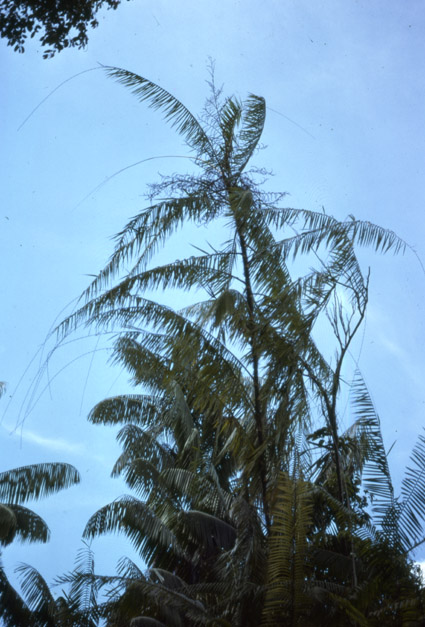- Acanthophoenix
- Acrocomia
- Actinokentia
- Actinorhytis
- Adonidia
- Aiphanes
- Allagoptera
- Ammandra
- Aphandra
- Archontophoenix
- Areca
- Arenga
- Asterogyne
- Astrocaryum
- Attalea
- Bactris
- Balaka
- Barcella
- Basselinia
- Beccariophoenix
- Bismarckia
- Borassodendron
- Borassus
- Brassiophoenix
- Burretiokentia
- Butia
- Calyptrocalyx
- Calyptrogyne
- Calyptronoma
- Carpentaria
- Carpoxylon
- Caryota
- Ceratolobus
- Ceroxylon
- Chamaedorea
- Chamaerops
- Chambeyronia
- Chelyocarpus
- Chuniophoenix
- Clinosperma
- Coccothrinax
- Cocos
- Corypha
- Cryosophila
- Cyphokentia
- Cyphophoenix
- Cyphosperma
- Daemonorops
- Deckenia
- Desmoncus
- Dictyocaryum
- Drymophloeus
- Dypsis
- Elaeis
- Eleiodoxa
- Eremospatha
- Eugeissona
- Euterpe
- Gaussia
- Geonoma
- Guihaia
- Hedyscepe
- Hemithrinax
- Howea
- Hyophorbe
- Hyospathe
- Hyphaene
- Iriartea
- Iriartella
- Itaya
- Jailoloa
- Johannesteijsmannia
- Juania
- Jubaea
- Jubaeopsis
- Kentiopsis
- Kerriodoxa
- Korthalsia
- Laccospadix
- Laccosperma
- Lanonia
- Latania
- Lemurophoenix
- Leopoldinia
- Lepidocaryum
- Lepidorrhachis
- Leucothrinax
- Licuala
- Linospadix
- Livistona
- Lodoicea
- Lytocaryum
- Manicaria
- Manjekia
- Marojejya
- Masoala
- Mauritia
- Mauritiella
- Maxburretia
- Medemia
- Metroxylon
- Myrialepis
- Nannorrhops
- Nenga
- Neonicholsonia
- Neoveitchia
- Nephrosperma
- Normanbya
- Nypa
- Oenocarpus
- Oncocalamus
- Oncosperma
- Orania
- Oraniopsis
- Parajubaea
- Pelagodoxa
- Phoenicophorium
- Phoenix
- Pholidocarpus
- Pholidostachys
- Physokentia
- Phytelephas
- Pigafetta
- Pinanga
- Plectocomia
- Plectocomiopsis
- Podococcus
- Pogonotium
- Ponapea
- Prestoea
- Pseudophoenix
- Ptychococcus
- Ptychosperma
- Raphia
- Ravenea
- Reinhardtia
- Retispatha
- Rhapidophyllum
- Rhapis
- Rhopalostylis
- Roscheria
- Roystonea
- Sabal
- Sabinaria
- Salacca
- Saribus
- Satakentia
- Satranala
- Schippia
- Sclerosperma
- Socratea
- Solfia
- Sommieria
- Syagrus
- Synechanthus
- Tahina
- Tectiphiala
- Thrinax
- Trachycarpus
- Trithrinax
- Veitchia
- Verschaffeltia
- Voanioala
- Wallaceodoxa
- Wallichia
- Welfia
- Wendlandiella
- Wettinia
- Wodyetia
- Zombia
- x Jubautia splendens
- ?? Acoelorrhaphe
- ?? Bentinckia
- ?? Brahea
- ?? Clinostigma
- ?? Colpothrinax
- ?? Copernicia
- ?? Cyrtostachys
- ?? Dictyosperma
- ?? Dransfieldia
- ?? Heterospathe
- ?? Hydriastele
- ?? Iguanura
- ?? Incertae sedis & excluded names
- ?? Loxococcus
- ?? Micronoma
- ?? Paripon
- ?? Pritchardia
- ?? Rhopaloblaste
- ?? Serenoa
- ?? Washingtonia

Distribution
Unaccountably rare in Brunei, known from a single collection. Elsewhere abundant in coastal formations throughout Borneo, Sumatra, Peninsular Malaysia and S Thailand, very rare inland. (Dransfield, J. 1997: The Rattans of Brunei Darussalam)A
Discussion
- C. erinaceus is an unmistakable and very beautiful species. It is one of the distinctive features of forest on the landward fringe of the mangrove; very rarely it can be found away from mangrove, but always near to the sea. Why it should be so rare in Brunei is not understood. (Dransfield, J. 1997: The Rattans of Brunei Darussalam)A
Etymology
- Like a hedgehog) (Dransfield, J. 1997: The Rattans of Brunei Darussalam)A
Uses
- Produces a medium to low quality coarse cane. (Dransfield, J. 1997: The Rattans of Brunei Darussalam)A
Description
- Robust clustering rattan tending to form thickets on the landward side of mangrove or behind coastal sand bars; stem climbing to 15 m, without sheaths 2-3.5 cm diam., with sheaths to 5 cm diam., rarely more, internodes to c. 30 cm. Sheaths orange-yellow to yellowish-green when fresh, very densely armed with slender grey-brown spines, 2-35 mm, held horizontally and arranged in horizontal or oblique whorls, spines and sheath epidermis densely covered with grey deciduous indumentum; spines around the leaf sheath mouth upward-pointing, grouped in 5’s to 9’s, the longest to 60 mm; knee and base of petiole very conspicuous, unarmed, orange-yellow, when young densely covered with indumentum. Leaf cirrate to 4.5 m long including the petiole to 25 cm and cirrus to 2 m; petiole armed along the margins only with grouped spines to 3 cm; leaflets to 70 or more on each side of the rachis, grey-green, very regular, close, limply pendulous, the longest to 40 × 2 cm, armed with short bristles along the margins and on the veins on the lower surface, the lower surface also with white wax and minute brown scales. Inflorescences to 1.5 m with very short peduncle enclosed by the leaf sheath; primary bracts armed with groups of short spines; partial inflorescences about 7 on each side of the axis, gradually decreasing in size distally; male rachillae 1-2 cm long with close distichous flowers; female rachillae 10 cm long with laxer distichous flowers. Fruit rounded, relatively small, to 1 cm diam., covered in 12 vertical rows of straw-coloured scales. Seed rounded, c. 7 mm diam.; endosperm homogeneous. Seedling leaf unknown. (Fig. 32, Pls 8A, 10A) (Dransfield, J. 1997: The Rattans of Brunei Darussalam)A
Materials Examined
- TUT: Telisai, Kpg. Danau, Wong 2094. (Dransfield, J. 1997: The Rattans of Brunei Darussalam)A
- Log in to post comments

